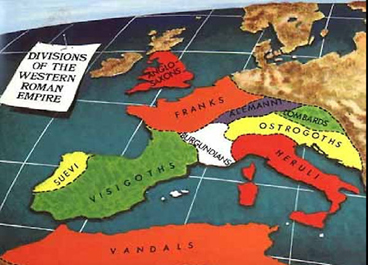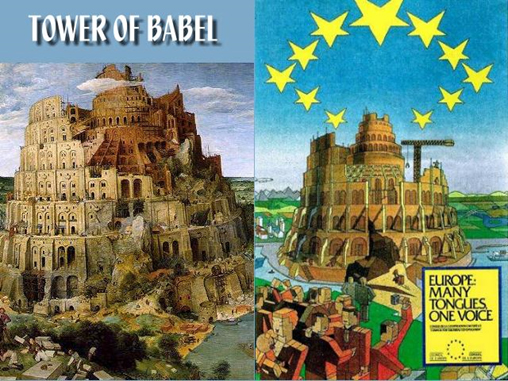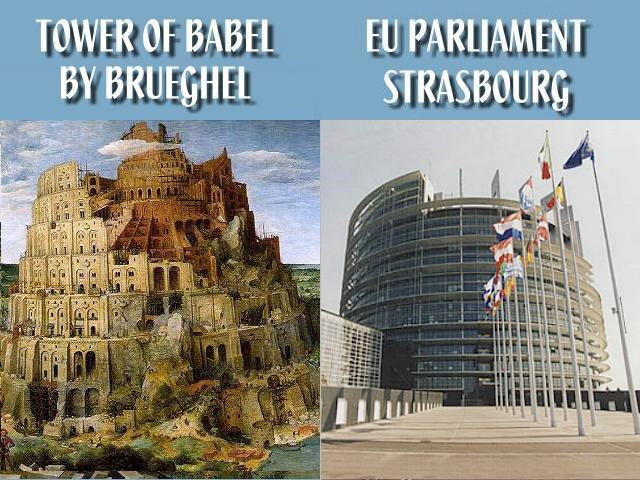
An Empire Established
TimeWatch Editorial
June 28, 2016
The Europe we know began with the disruption of the Roman Empire in 476 A.D. when ten Germanic tribes invaded and took control. These ten Germanic tribes were the Franks, the Alemanni, the Lombards, the Suevi, the Anglo-Saxons, the Burgundians, the Visigoths, the Heruli, the Vandals and the Ostrogoths. As you can clearly see from the map below, those divisions represent the present continent of Europe and part of Northern Africa.
The Franks we now know as the French, the Alemanni the Germans, the Lombards the Italians, Suevi the Portuguese, the Anglo-Saxons the British, the Burgundians the Swiss and the Visigoths, Spain. You might be curious to know what ever happened to the Ostrogoths, the Heruli and the Vandals. Well, even though the Roman Empire was dissolved, there remained the powerful influence of the Roman Catholic Church.
“Roman history did not end with the division. Daniel watched, "and, behold, there came up among them another little horn, before which there were three of the first horns plucked up by the roots." A new power, one outside the empire, is here represented by the little horn. The three divisions which were plucked up were the Heruli in 493, the Vandals in 534, and the Ostrogoths in 538 A.D. Justinian, the emperor, whose seat was at Constantinople, working through his general Belisarius, was the power that overthrew the three kingdoms represented by the three horns, and the reason for their overthrow was their adherence to Arianism in opposition to the orthodox Catholic faith.” Stephen N. Haskell, The Story of Daniel the Prophet, Page 51.
Now Arianism was a heretical belief that Jesus has been created by the Father and was by no means equal in power of in dignity. Ultimately the three non complying divisions were done away with and the Holy Roman Empire, which we now describe as Europe was united. Even though we today tend to ignore the beginnings of this continent’s established union, the relevance still influences everything that occurs there. From 538 to 1798, the element of control and stability remained in the Holy Roman Empire, until that deadly wound so often referred to occur. The Pope was removed from his palace and placed in prison and the Papal States were taken away. It was not until the Lateran Treaty that the wound was healed.
“The Lateran Treaty was one of the Lateran Pacts of 1929 or Lateran Accords, agreements made in 1929 between the Kingdom of Italy and the Holy See , settling the "Roman Question ". They are named after the Lateran Palace , where they were signed on February 11, 1929. The Italian parliament ratified them on June 7, 1929. Italy was then under a Fascist government , but the succeeding democratic governments have all upheld the treaty. It recognized the Vatican as an independent state, with Prime Minister Benito Mussolini agreeing to give the church financial refund.” A History of Western Society (Tenth ed.). Bedford/St. Martin's. p. 900 .
The Lateran Treaty did not however restore the empire. Our three editorials in the month of January, “The Rise of and Empire” parts 1-3 gives the detail of the reestablishment. What was not shown then was the symbol used in the reconstruct of the Empire as we now know it to be, the European Union.
| On the left is a painting done in 1563 of the Tower of Babel, by Pieter Brueghel the Elder, a Flemish Northern Renaissance Painter. On the right is a poster produced by the European Union symbolically depicting their mission. It combines the 12 stars of the EU flag with the rebuilding of the tower of Babel with the motto Europe: Many Tongues One Voice. Note also that the stars are shown as inverted pentagrams. |
As if that were not enough, the European Union Building located in Strasbourg is also based upon the very same symbol.
Would you believe there’s more? There is much more. We will continue in our next editorial.
Cameron A. Bowen







